St Mary’s Church History
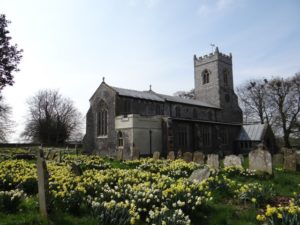
According to the Doomsday Book of 1086 there was a church in Baconsthorpe attached to one of the Lordships which belonged to Robert Grenon that was endowed with 30 acres of land, 80 sheep and 40 goats. The earliest parts of the present church date from the 13th century and stand on Saxon foundations. Two of the arcades in the nave nearest the chancel are of the decorated style used between 1290-1350.
The church is a large building of flint and freestone. White flints have been knapped and squared and laid in courses, these are intended to reflect the early morning and late evening sunshine which will catch the eye from a distance.
The Heydon Family, Baconsthorpe Castle & The Church
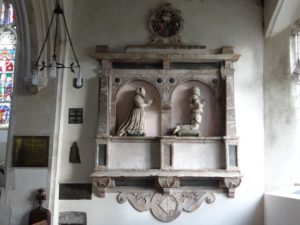
The Heydon Memorial is an impressive alabaster monument to Sir William Heydon and his wife, Anne Woodhouse, dated 1592. It is strange they are both facing south and not east. It seems likely that the memorial was made for the chancel but proved too large and was subsequently moved to the south aisle.
To the left of the Heydon Memorial are some brasses. The brass figure of a lady kneeling is Lady Ann Heydon who died in 1561, first wife of Sir Christopher Heydon II. She is wearing a Mary Stewart cap and ruff with a small heraldic mantel fastened by chords reaching to her feet. This brass was originally fixed to a tomb in the church along with figures of Sir Christopher and Temperance, his second wife. The brass inscription can now to be seen on the sill of the window at the east of the south aisle.
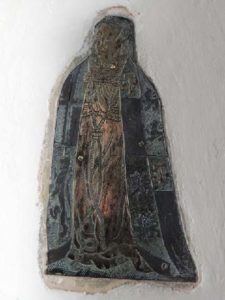
Sir Christopher Heydon II (1561-1623) was lord of the manor of Baconsthorpe at the height of the family fortunes and owned large estates in Norfolk and Kent. He once entertained at a Christmas dinner 30 Master Shepherds of his own flocks. His elder son, Sir William, began the family’s downfall with unfortunate speculations in the City of London and had to sell much of his property to pay his debts.
Above the brass of Lady Ann Heydon is a curious style of brass, though not uncommon in the days of Elizabeth I. It depicts a human breast distilling four drops of milk and is the coat of arms of the family of Lady Ann Heydon. This brass, together with the inscription below the brass of Lady Ann Heydon, were placed in a stone over her grave somewhere in the church.
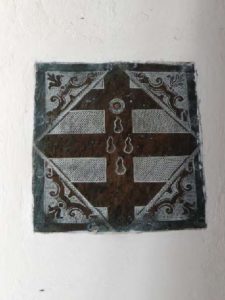
Above these brasses is a brass shield which probably belongs to the tomb on the north wall of the chancel to Sir John Heydon. Only two other shields remain in situ. It originally contained the figures of Sir John Heydon (died 1550 aged 82) and his wife Catherine (died 1542 aged 72) and the Heydon crest and motto “Regard que suyst de verture null male”.
Below the brass of Lady Anne is a small square brass which is the oldest in the church. In translation it reads “Pray for the sole of Henry Heydon – Armiger. September 15th, 1479”. An armiger has the right to bear arms.
The windows in the south aisle are 15th century perpendicular style and have the Heydon family arms set in them. Originally these shields were in the windows of the banqueting hall at Baconsthorpe Hall (now called Baconsthorpe Castle). When the hall was largely pulled down in 1650 these arms were removed and placed in the east window. They were again moved in 1861 to make way for the present stained-glass window and inserted into the clerestory windows of the chancel. During repairs following bomb damage from 1942 they were relocated to the south aisle in 1958.
The full Heydon coat of arms shows a Dalmatian dog sitting on a blue helmet over the red and white quartered shield. The Heydon shield is
seen repeatedly in the windows. The shield with the boar’s head is Heydon with Boleyn and the shield with the blue and yellow chequers is Heydon with Gurney.
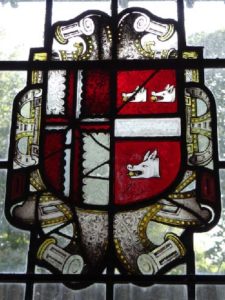
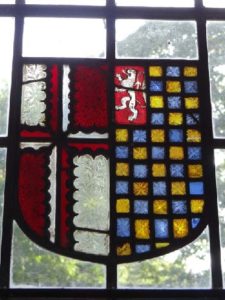
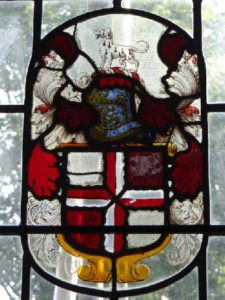
Other Points of Interest
On the right side of the altar is a beautiful perpendicular piscina (c1250) with trefoiled arches on marble shafts, a third arch joins it to the sill of a lowered window forming a sedilia. There is a single basin under the western arch which gives an earlier date to the chancel than might be guessed by the style of the windows. The window on the south side of the chancel, together with the priest’s door and sedilia, were discovered in the restoration of 1869. In the doorway were masses of broken stones and the mouldings in the arches of the nave were filled up with plaster.
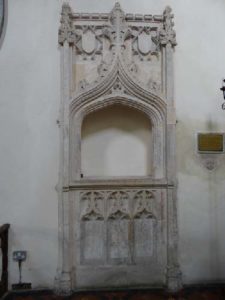
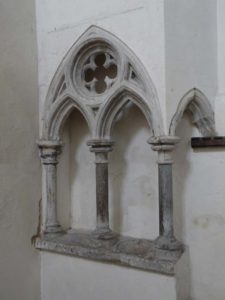
On the left side of the altar there is an Easter Sepulchre, a fine piece of 15th century work. It has rich crocketting of the pinnacles
and blank shield which may have been painted. This is one of only three remaining in Norfolk. The one at Kelling is similar to this and
what was a fine example at Northwood has been badly damaged over the years. The cross and host would have been placed here on Maundy Thursday until Easter Sunday.
There are remains of a benatura near the vestry door, which was used for holy water until the practice was discontinued in the mid 16th century by breaking the bowl. They were usually sited nearer to the entrance door than this one.
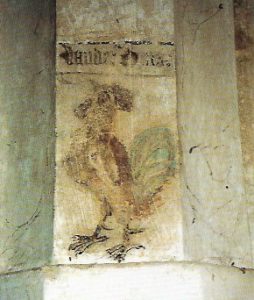
Chanticleer is the cock painted on the arch at the east end of the south arcade. He is 14th century, singing “Laudat Dominum” –
“Praise the Lord”.
The window above the altar has glazing by William Wailes (1861) depicting the Resurrection, Crucifixion and Ascension with panels of corresponding Old Testament scenes below, namely Jonah, Isaac and Elijah. This is a fairly early Victorian glazing; the colours are rich, but the drawing is somewhat crude.
The west window opposite the altar (in the bell tower) shows Moses, the Good Shepherd and Elijah. This was made by James & John King in 1865 in their works in St Andrew’s Plain, Norwich. The square western embattled tower collapsed in 1739, damaging the nave, roof and font. Repairs to the nave were started immediately, using the money from selling the two broken bells. The tower was not fully repaired until 1788. This lack of interest in restoration work was typical of the 18th century. A parish record from 1768 mentions a church warden who served on and off for 40 years and never put the parish to any expense! Finally, a parish rate was raised to help pay for the tower and the rector, William Hewett, agreed to contribute £13 a year. The church was described in 1768 as “being in a very ruinous and deplorable state”.
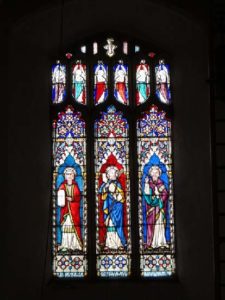
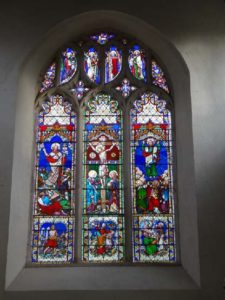
There is one bell which bears the inscription “Charles Newman made me 1701”, made by the itinerant bell maker from Norwich, not very well it seems as a large piece had broken off from the bottom which for many years accounted for the dull sound of the bell only heard when the clock chimed. In 1992 the bell was repaired by a local farmer, Roger Hall, in memory of his parents.
There are also eight tubular bells erected in 1892 at a cost of £200.00.
The clock was given in 1888, the gift of Annie Smith, youngest daughter of Mrs Webb.
The font was presented by J Hales Esq of Holt in 1886. This replaced a marble font presented to the church in 1779 by Mrs Mary Ann Stewart, which until 1955 stood in the west end of the south aisle. In that year the parochial church council decided to give the font to St Bartholomew’s Church, Heigham Street, Norwich, as their own had been destroyed in the second world war. After the present font had been erected it was found to be subsiding and on examination a coffin was discovered under the pavement. It was elaborately fitted, covered with crimson velvet and highly ornamented; possibly a burial place of one of the Bacons.
The Tower Screen is made from the 15th century pew backs held in a frame erected in 1924. They were found in the roof when parts were restored in 1910.
The roof timbers are enhanced by carvings of angels with outstretched wings above (can you find the monkey amongst the carvings?). Amongst the painted shields look for the crown with a “M” for Mary in the centre; three fat pigs for the Bacon family and the engrailed cross for the Heydon family. The chest by the north door was purchased in 1547 for the sum of ten shillings, which was raised by selling some of the church plate.
The Rectory
In 1692 the rectory, then a small cottage, was struck by lightning and burnt down and all the church records were lost. The rector, Joseph
Clark, built a new rectory but “as he married a wife and had many children ‘tis no wonder he covered the new house with a roof of thatch”. This building was again burnt down by a fire in the wash house chimney in 1754. The present rectory was completed in 1770 at the expense of Zurishaddai Girdlestone, the rector and lord of the manor and the parishioners, quite a drain on the resources as they were then restoring the church. The south and west elevations where added in 1840 by John Whiting aided by a grant from Queen Anne’s Bounty. The north wing of the building suffered bomb damage in 1942. It is now a private residence.
Recent Renovations
The church was unsympathetically restored in 1869 at the cost of £1,300, when most of the woodwork was renewed including the pews. These replaced the box pews erected in 1700.
In 2014 the lead was renewed on the chancel roof and repairs were made to the vestry, thanks to a Heritage Lottery Fund Repair.
Grants for Places of Worship
Sadly in 2017 there were two instances of lead being stolen from the roof. Although the thieves were caught and sent to prison the lead
was not recovered. In 2018 St Mary’s Church was awarded a Heritage Lottery Fund grant for 70% of the costs of repairing roof with various fund-raising efforts raising the remaining 30%. Work commenced on the roof repairs in 2018.



